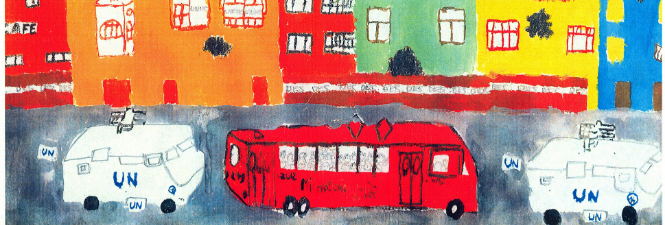
TRIO Sarajevo Postcards
Members of the graphic design group Trio Sarajevo — Bojan and Dalida (Durakovic) Hadzihalilovic and Leila Mulabegovic) — met at the Sarajevo Academy of Fine Arts in 1985. By the time they graduated in 1989, their pop art and punk-influenced work gained the attention of a national and global audience. They reworked the iconic Beatles album cover Sgt. Pepper’s Lonely Hearts Club Band for the Bosnian rock group Plavi Orkestar (Blue Orchestra). That same year, Trio won a coveted Saatchi & Saatchi award for their TV and advertising work and formed a marketing agency called Fabrika.
Trio had opportunities to work abroad when war broke out in Bosnia in 1992, but they decided to stay in order to inform the outside world about what was happening in their beloved capital city during the siege. The design group diligently produced postcards and posters while confined in the city for the next four years.
Trio purposely used (and reworked) images familiar to citizens throughout the world to capture their attention and demonstrate their common culture and humanity. Some postcard messages are funny (“Never Mind the Bollocks, Here’s the Sarajevo”), while many are more serious and sinister: the Olympic rings made from barbed wire; Superman’s shield being pummeled by bullets; Sarajevo’s version of Warhol’s soup cans with bullet holes; a standard New Year’s card with fireworks also features a bomb dropping.
Some postcards are an appeal to their own people. In a take-off of an Absolut Vodka advertisement, Trio replaced the contents of the vodka with the contents and aspirations for Bosnian unity on the label. Some are an appeal for help from the outside world. Trio used recruitment posters from World War I and II to rally the global community: “Wake up Europe! Sarajevo Calls…” Uncle Sam commands, “I Want You to Save Sarajevo.” In one series, Trio created a number of Olympic Games images dated 1994 instead of the actual date of the Winter Games: 1984. Trio may have been pleading, “World, we captured your attention a decade ago, why not now in our time of need?”
In a time before widespread news websites and social media could record and broadcast injustices and atrocities to audiences everywhere, it is highly symbolic that Trio chose to create postcards, a medium that is meant to be a document of travels mailed back to family and friends.
In an introduction to the poster exhibit, “Greetings from Sarajevo 1993,” Aleksandar Hemon said of Trio, “They re-designed images, re-branded brands, re-configured the outside reality, creating their postcards to send them to the world in order to show that Sarajevo never left it. It was the world that left Sarajevo.” (Galerija 11/07/95)
Indeed, Trio revised the famous Pink Floyd album cover for The Wall, crossing out “Berlin” and putting “Sarajevo” in its place. Trio, no doubt, felt that walls bolstered by politics, misunderstandings, and ethnic strife separated Bosnians from each other and the global community. And Trio desperately wanted to get back what was lost.
Trio Sarajevo’s work has been exhibited worldwide and published in books, newspapers, and magazines, including Life, Newsweek, the Los Angeles Times, The Independent, The Guardian, Art Press, and Creative Review. The award-winning Fabrika is now one of the largest multimedia creative, digital, and advertising agencies in Bosnia & Herzegovina.
The Center for Bosnian Studies’ collection features four postcards and a 20-postcard compilation produced by Trio Sarajevo. We hope that sharing these images will inspire viewers to seek out additional examples of their work and reflect upon the courage and resilience these images represent. Trio worked to distribute their art across war-torn Bosnia and beyond its borders in an effort to reach both the individuals on the ground and the outside world. Here, we hope they will reach a new audience and provide an important piece of the story of the city and its people during the siege.





